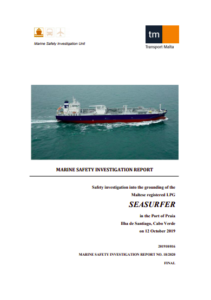The Maltese registered LPG tanker Seasurfer ran aground in the Port of Praia in October 2019, as the pilotage section of the passage plan contained no specific directions on manoeuvring with the use of tug/s at Praia, investigation by Transport Malta MSIU revealed.
The incident
At about 1700 on 12 October 2019, the Maltese registered LPG tanker Seasurfer ran aground in the Port of Praia, Ilha de Santiago, Cabo Verde.
Prior to the grounding, Seasurfer was manoeuvring in the port’s turning basin to berth port side alongside. A local pilot was on board and one harbour tug was assisting the vessel.
Soon after dropping anchor off the assigned berth, the vessel took a sudden sheer to starboard. The tug, helm and the ship’s main engine were used to check the sheer and align the vessel with the jetty.
However, the subsequent action of the tug’s thrust, the vessel’s propulsion, helm and anchor, caused the stern to swing to port and set lateral movement towards the inner side of the breakwater.
The increased speed ahead averted the stern closing-in on the breakwater but the bulbous bow came in contact with the seabed. Seasurfer was pulled back in the turning basin but the subsequent manoeuvres swung the vessel rapidly to starboard and the port side ran aground on the shoaling depth, just outside the periphery of the turning basin.
Seasurfer sustained damages to the bulbous bow, tips of the propeller blades and underwater hull port side. There was no hull breach and no oil pollution.
Immediate safety factor
The vessel’s bow advanced beyond the limits of the navigational fairway and came in contact with the shoaling depth.
More safety factors
- The pilotage section of the passage plan contained no specific directions on manoeuvring with the use of tug/s at Praia;
- No navigational hazards or constraints were anticipated in the approach to the port or in the port’s turning basin and the master did not query the need for a second tug;
- Watching the stern fast approaching the jetty may have been perceived an unacceptable risk by the master and may have also contributed to an increase level of stress;
- The exceptionally large leverage and inertia of rotation when the starboard anchor hit the sea bed, exacerbated the rate of turn and Seasurfer swung further to starboard, heading almost West;
- As the situation evolved, the master and the pilot did not share a common mental model and their goals to reach an unequivocal objective were in conflict;
- Subsequent ahead propulsion, helm hard over to starboard, weighing the anchor and the tug pushing on the starboard quarter concurrently resulted in the vessel rapidly turning around to starboard and the port side ran aground on the shoal just outside the periphery of the turning basin;
- Hydrodynamic interaction of forces of the tug’s thrust, vessel’s forward and stern motions, effectiveness of the helm in shallow water, environmental conditions, anchor leading aft and frequently under strain, made the situation more complex.
Actions taken
The Company issued a Fleet Circular, establishing a new procedure for non-routine ports whereby prior to calling a new port, all masters are required to:
- submit to the Company’s superintendent passage plan, UKC calculation, and risk assessment of all sections of the passage including but not limited to, the main engines and approach to the pilot station, pilot boarding, master / pilot exchange of information, tugs for berthing / mooring, mooring layout and manoeuvring in port, for their review;
- contemplate in advance alternative ways to conduct the pilotage operations or abort the operation anytime if not confident;
- monitor the weather and confirm with the local agent 24 hours prior to berthing; • to review the guide to port entry with the Company’s superintendent and collate information on port facilities, including tugs, mooring, pilotage, etc., and confirm with the local agent;
- conduct an extraordinary meeting on board to discuss navigation under pilotage, working with tugs, mooring operation and contingency plans (details of the meeting / discussion to be sent to the Company office); and
- evaluate the port facilities and submit their comments / findings to the Company after calling at a new port.
Moreover, Company’s superintendents are required to review and advise senior Company officials whether the designated new port is safe or not.
Recommendations
In view of the investigation and subsequent actions, Transport Malta recommends the Port Authority of Praia to:
- review and develop guidelines on optimal use of tugs for safe ship movements in the port and its approaches.
- consider providing a pilotage / manoeuvring plan prior to their arrival or as soon as practicable to masters of vessels carrying dangerous goods.
Explore more herebelow:































































